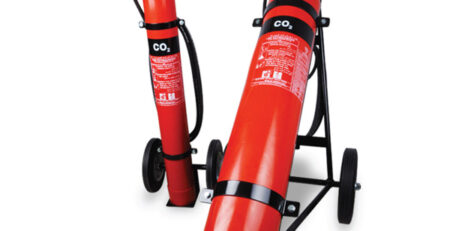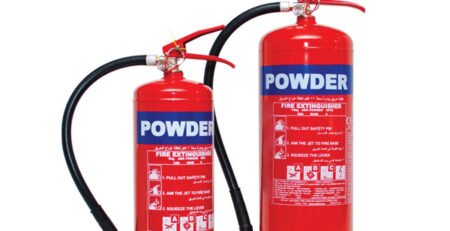Types of Fire Extinguishers and Their Uses
Fires can occur at anytime, anywhere, whether at home, in the workplace, or on the road. Having the right fire extinguisher is essential for ensuring safety and preventing a small flame from escalating into a full-blown disaster. At Five Star Trading, we understand the importance of proper fire safety and are committed to providing you with high-quality fire extinguishers that suit your specific needs.
In this blog, we’ll guide you through the different types of fire extinguishers available in the market and their ideal uses. Understanding the different classifications will help you make the best choice when purchasing a fire extinguisher for your property or business.
-
Water Fire Extinguishers (Class A)
Water fire extinguishers are one of the most common and widely used types of fire extinguishers. These extinguishers are specifically designed to combat fires involving solid materials such as wood, paper, and textiles.
Use: Water fire extinguishers should only be used on Class A fires, which involve ordinary combustible materials. Never use a water fire extinguisher on electrical fires or flammable liquid fires, as water can cause further damage or cause the fire to spread.
Key Features:
- Effective for most common household fires
- Easy to use and widely available
- Cost-effective solution
-
Foam Fire Extinguishers (Class A and B)
Foam fire extinguishers are versatile tools designed to handle both solid materials (Class A) and flammable liquids (Class B). Foam works by forming a blanket over the fire, suffocating the flames and preventing oxygen from fueling the fire.
Use: Foam fire extinguishers are ideal for dealing with fires caused by flammable liquids like oil, petrol, or paints, as well as solid combustibles like wood or paper. They are commonly used in commercial settings, including kitchens and garages, where both types of fire hazards exist.
Key Features:
- Suitable for both liquid and solid fires
- Creates a barrier that prevents re-ignition
- Suitable for commercial and industrial settings
-
Dry Powder Fire Extinguishers (Class A, B, C, D, and Electrical)
Dry powder fire extinguishers are some of the most versatile fire extinguishers available today. These extinguishers are designed to put out a wide range of fires, from solid materials to flammable gases and electrical fires.
Use: Dry powder extinguishers can be used on Class A, B, and C fires (solid materials, liquids, and gases) as well as electrical fires. However, they are not suitable for use on cooking oils or fats, making them less effective in kitchens.
Key Features:
- Multi-purpose; effective against different types of fire
- Fast-acting
- Often used in vehicles, industrial settings, and garages
-
CO2 Fire Extinguishers (Class B and Electrical)
Carbon dioxide (CO2) fire extinguishers are excellent for tackling fires involving electrical equipment and flammable liquids. The CO2 displaces oxygen, effectively suffocating the fire.
Use: CO2 extinguishers are ideal for electrical fires (e.g., in server rooms, offices, or factories with electrical equipment) and Class B fires involving flammable liquids like oils or chemicals. These extinguishers are also often used in labs and other environments where electronic devices are a major fire risk.
Key Features:
- Leaves no residue, making it ideal for use on electrical equipment
- Effective against flammable liquids
- Quick and efficient for confined areas
-
Wet Chemical Fire Extinguishers (Class F)
Wet chemical fire extinguishers are specially designed for tackling fires that occur due to cooking oils and fats, typically in commercial kitchens or restaurants.
Use: These extinguishers are specifically used for Class F fires, which involve cooking oils and fats, such as those found in deep fryers and cooking equipment. The wet chemical agent cools the oil and forms a layer to prevent re-ignition.
Key Features:
- Highly effective in kitchen environments
- Forms a barrier to prevent re-ignition
- Tailored to meet the demands of the food industry
-
Class K Fire Extinguishers
Class K fire extinguishers are another variation of wet chemical extinguishers. They are used for fires involving cooking oils and fats, but they are particularly suited for higher temperatures found in commercial kitchens.
Use: Class K extinguishers are often found in larger restaurant kitchens or food processing plants, where high-temperature oils and fats are used for cooking. They are designed to handle fires that are more intense than typical kitchen fires.
Key Features:
- Ideal for high-temperature cooking environments
- Designed specifically for deep-fat fryers and cooking oils
- High-performance extinguishing agents
Choosing the Right Fire Extinguisher
Selecting the correct fire extinguisher depends on the type of fire hazard you’re likely to face. For example, residential properties should typically have a water or foam extinguisher, while commercial kitchens or laboratories may require CO2 or wet chemical extinguishers.
At Five Star Trading, we provide a range of fire extinguishers suited for both residential and commercial use. When choosing the right extinguisher, consider factors such as the type of fire risks, the size of the area you need to protect, and the regulatory standards for your industry.
Conclusion
Incorporating the correct fire extinguisher into your fire safety plan is crucial to ensuring the safety of your home, business, or property. Five Star Trading offers a comprehensive range of fire extinguishers tailored to your needs, with expert guidance to help you make the right choice.
Remember: Always regularly inspect your fire extinguishers to ensure they are in working condition, and ensure that your staff or family members are trained in their proper use. Fire safety can be the difference between a minor incident and a major disaster.
Contact Five Star Trading today to explore our selection of fire extinguishers and secure your space against the risks of fire. Stay safe, stay prepared!



Leave a Reply